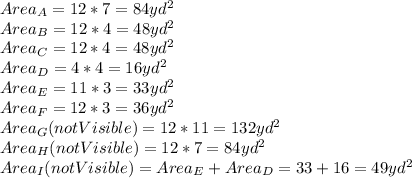Answer:
Surface Area =

Explanation:
*This answer is for the problem on the left that seems unanswered*
Firstly, you must understand that the surface area of an irregular polygon like the one in the problem must be found by dividing its faces into rectangles and finding the sum of the areas of those rectangles.
Another way to say this is that the surface areas of these solids can be found by adding up the areas of the rectangles that make their faces.
You will see that I attached a picture that divides the solid's faces into subsections, labelled a through i, including faces that are not visible in the diagram.
If you divided the solid's faces in the same way as the picture, the surface area is found as follows:

By the way,
 is the same as "square yards".
is the same as "square yards".
After finding the areas of each rectangle, add them all up to get your final answer:
